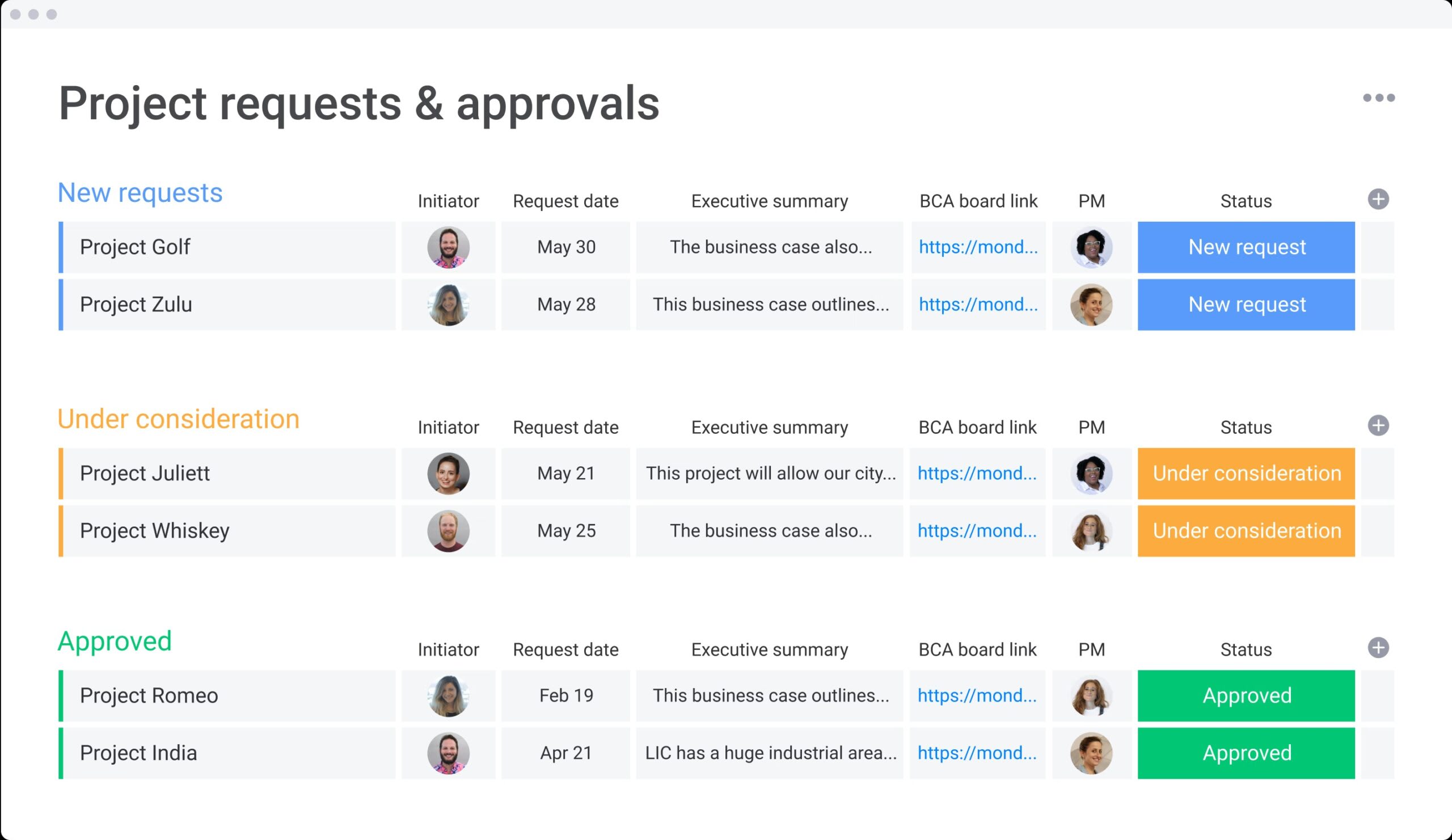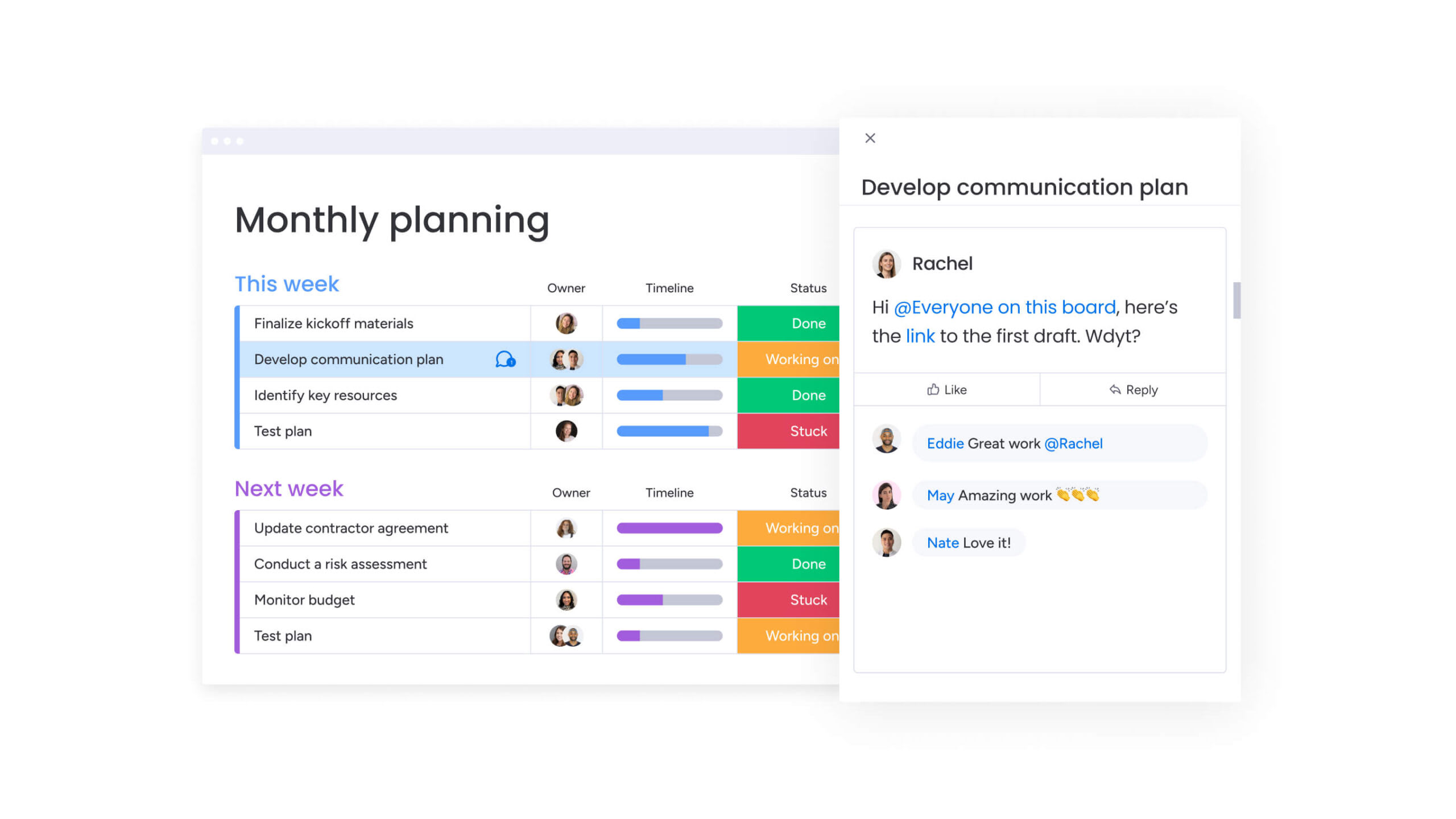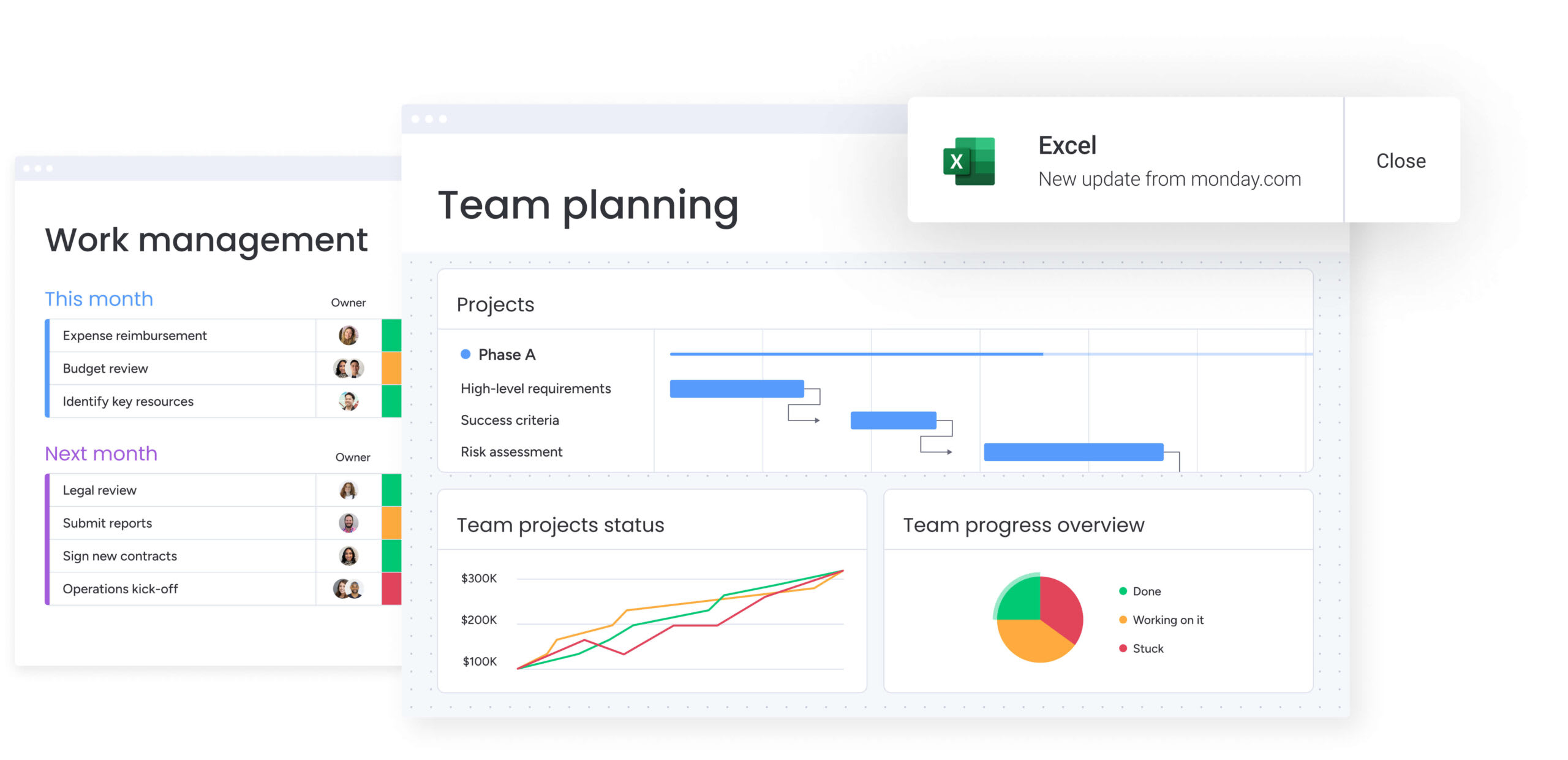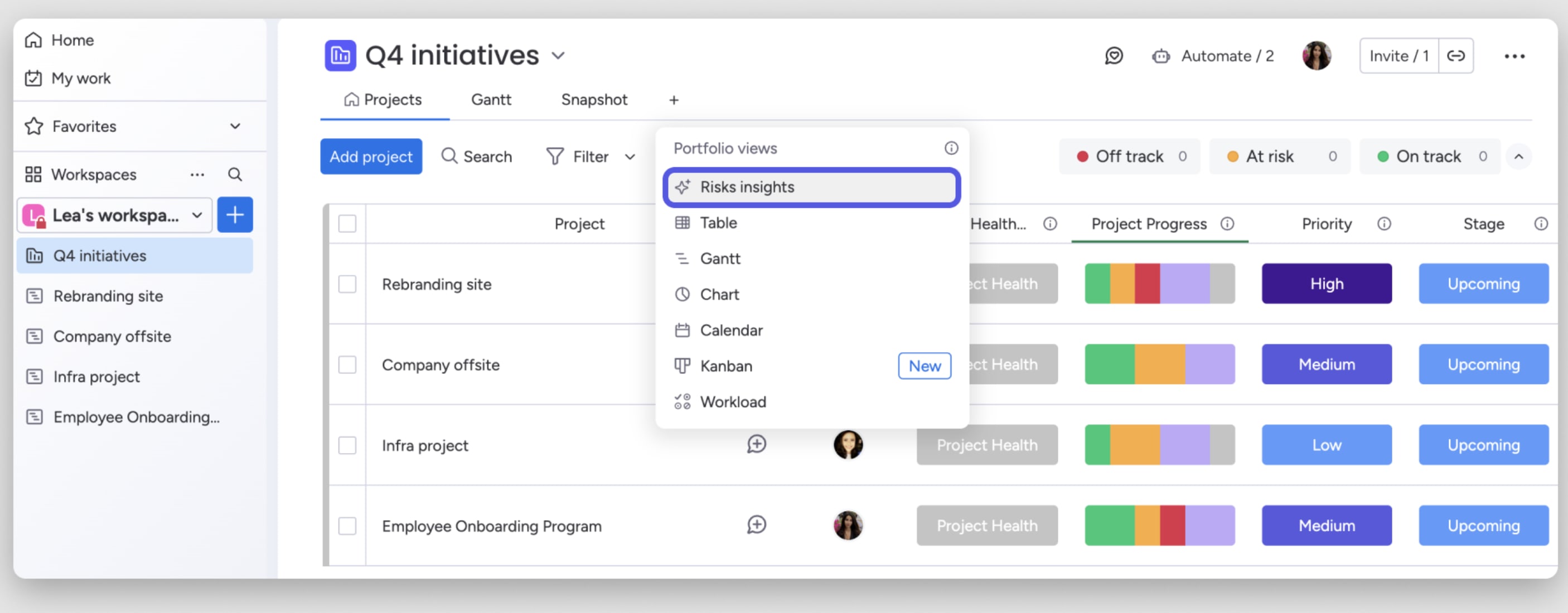No matter the size or scope of a project, without proper foundations, it’ll crumble under pressure. Project setbacks occur in organizations of all sizes, with the majority of initiatives missing their mark despite significant investment and effort.
This guide breaks down the 10 most common causes of project failure and provides practical prevention strategies for 2025. By understanding these pitfalls, you’ll be equipped to spot warning signs early and implement solutions that keep your projects on track. We’ll also take a look at how monday work management’s visual approach to project planning helps teams prevent project failure through more proactive planning, communication, and execution.
Try monday work managementWhat is project failure and why does it happen?
A project fails when it doesn’t deliver required outcomes within agreed-upon budget and timeline constraints. Project failure can be complete (abandoned entirely) or partial (delivered but missing key objectives or vastly exceeding resources).
According to the Project Management Institute, organizations lacking adequate project management strategies experience failure rates over 60%. Only one-third of projects are completed on time and within budget.
Why do projects fail so frequently? The answer typically involves a combination of factors rather than a single issue.
Recognizing these early indicators can save you from major setbacks. Each signal represents a specific project health concern you can address if caught early. These indicators often signal a failing project, serving as early warning signs that demand immediate attention before small issues cascade into catastrophic outcomes:
- Missed deadlines: Timeline extensions beyond original plans
- Budget overruns: Costs exceeding initial estimates
- Unmet objectives: Deliverables missing critical requirements
- Stakeholder dissatisfaction: End users rejecting the final product
The real cost of failure
Project failures create tangible financial impacts. When Nike implemented a faulty supply chain management system, the company missed its third-quarter earnings by at least 28% , showing how technical failures directly impact bottom-line results.
10 common causes of project failures
Understanding why projects fail helps teams identify risks early and implement preventive measures. Most unsuccessful projects suffer from multiple factors creating a cascade of issues that ultimately derail progress.
1. Unclear objectives and scope creep
Scope creep occurs when project requirements continuously expand beyond original agreements. This happens when initial objectives aren’t clearly defined and documented.
According to Project Management.com, over 17% of projects suffer due to poor planning. Without a definitive vision of success, teams struggle to deliver meaningful results.
A classic fail project example: The Healthcare.gov website launch faced massive scope issues with constantly changing specifications. Of eight million early visitors, only around 1% successfully enrolled due to unclear requirements.
2. Poor communication
Communication breakdowns create misunderstandings about priorities, responsibilities, and progress and are among the most common project management challenges . This challenge magnifies in distributed teams where face-to-face interaction is limited.
When information becomes siloed, alignment suffers. According to research, ineffective communication puts approximately $75M of every $135M at risk due to workflow disruptions.
Monday work management platforms centralize communication, ensuring everyone accesses the same information regardless of location or department.
3. Insufficient planning
As Benjamin Franklin noted , “You plan to fail when you don’t plan.” Rushed planning phases inevitably lead to projects operating in reactive mode rather than following strategic roadmaps.
Comprehensive planning involves several critical elements that prevent project failures:
- Risk assessment: Identifying obstacles before they occur
- Resource allocation: Ensuring appropriate staffing and materials
- Milestone definition: Creating clear checkpoints to measure progress
- Contingency planning: Preparing for unexpected challenges
Without these elements, teams face constant firefighting rather than methodical execution.
4. Unrealistic timelines
Pressure to deliver quickly often results in timelines that ignore execution complexity. This planning fallacy of underestimating required time affects even experienced project managers.
Unrealistic deadlines create a domino effect: rushed work leads to quality issues requiring rework, further delaying timelines and creating a cycle of missed deadlines.
How can you create more realistic project timelines? monday work management’s historical data analysis helps teams establish achievable deadlines based on past performance.
5. Limited resources or budget
According to Project Management.com, inadequate resource forecasting causes project failure over 20% of the time. When teams lack sufficient people, tools, or funding, they face resource management challenges that compromise quality.
The Texas child support enforcement system provides a cautionary example of failed information technology projects, with $367.5 million invested in a system that ultimately failed due to resource misallocation.
6. Lack of stakeholder engagement
Stakeholders provide critical direction, feedback, and support throughout project lifecycles. When they disengage, projects lose alignment with business objectives and face approval delays.
Effective stakeholder management prevents projects that fail through:
- Regular progress updates
- Early involvement in planning
- Continuous feedback mechanisms
- Clear expectation alignment
monday work management’s automated reporting keeps stakeholders informed without creating additional work for project teams.
7. Resistance to change
Organizational resistance manifests as reluctance to adopt new processes or technologies. This resistance often stems from fear of disruption to established routines.
The Lidl inventory system implementation exemplifies this challenge. After seven years and approximately €500 million , the project was abandoned because the organization couldn’t adapt to new processes.
Change management principles that prevent project failing include clear communication about necessity, training for affected teams, and visible executive sponsorship.
8. Weak risk management
Proactive risk management identifies potential issues before they impact projects. In contrast, reactive approaches address problems only after they’ve caused delays or budget overruns.
How effectively does your team anticipate problems before they arise?
Many IT project failures stem from unaddressed technical risks like integration challenges or data quality issues that weren’t identified early enough to develop contingency plans.
9. Inadequate governance
Project governance establishes decision-making frameworks, roles, and responsibilities. Without clear governance, projects suffer from delayed decisions and accountability gaps.
The Knight Capital Group provides a dramatic example of governance failure in failed projects project management. A simple deployment error caused the company to lose $440 million in just 45 minutes because proper checks weren’t in place.
monday work management’s approval workflows ensure proper oversight at critical decision points.

10. Technology challenges
Technical complexity contributes significantly to IT failed projects. Integration issues, data quality problems, and performance bottlenecks can derail even well-planned initiatives.
The UK’s National Health Service IT program illustrates technology challenges in failed software projects. Originally budgeted at approximately £6 billion , the program faced massive technical hurdles integrating complex healthcare systems.

How to ensure successful projects in 2025
Prevention strategies have evolved significantly with modern work approaches and technology. Forward-looking organizations implement systematic approaches to address common causes of failures in project management.
Is your organization leveraging these advanced prevention strategies?
Clear documentation forms the foundation of successful projects. Establishing unambiguous objectives ensures everyone shares the same understanding of success. monday work management centralizes documentation, making it accessible to all stakeholders.
Data-driven decision making represents a significant advancement in preventing project management failures. By leveraging real-time metrics, teams identify trends and make course corrections before issues impact deadlines.

Implementing these key practices creates a foundation for project success that dramatically reduces failure rates:
- Clear documentation: Establishing unambiguous requirements
- Stakeholder alignment: Ensuring shared vision
- Regular check-ins: Maintaining consistent communication
- Flexible methodology: Adapting approaches to project needs
- Data-driven decisions: Using metrics to guide adjustments
Lessons learnt and key takeaways from real projects
Examining examples of failed projects provides valuable insights for prevention. These examples highlight how seemingly different projects often fail for similar reasons.
Boeing 737 MAX Software System
This catastrophic example of a project that failed resulted in two fatal crashes and the global grounding of 737 MAX aircraft for nearly two years, costing Boeing billions in losses.
The primary causes were rushed development timelines, inadequate systems integration testing, poor risk management, and critical design flaws in the MCAS software system that weren’t properly communicated to pilots.
Key lesson: Thorough safety testing and transparent documentation are essential for mission-critical systems, especially when human lives depend on proper functionality.
Lidl inventory management system
German retailer Lidl abandoned its SAP implementation after seven years and approximately €500 million invested. The failure stemmed from attempting to force Lidl’s existing inventory management processes into SAP’s standard software framework rather than adapting their operations to align with the system’s capabilities.
This fundamental mismatch created significant technical complications, as developers spent countless hours customizing the SAP system to mirror Lidl’s legacy processes instead of leveraging the software’s built-in efficiencies. The project ultimately collapsed under the weight of escalating costs, missed deadlines, and mounting frustration from stakeholders who couldn’t see a viable path to completion.
Key lesson: Software implementations require organizational flexibility and change management.
Target Canada expansion
Target’s expansion into Canada resulted in losses of $2.5 billion and closure of all 133 Canadian locations less than two years after entry, providing a dramatic failed IT projects example.
The causes were an unrealistic 24-month timeline for opening 124 stores simultaneously, critical supply chain system failuresthat left shelves empty, poor data qualitywith over 30% of product information containing errors, and an inadequate localization strategy that failed to adapt to Canadian consumer preferences and market conditions.
Key lesson: Successful market expansion requires thorough planning, robust supply chain systems, accurate data management, and careful adaptation to local market conditions rather than rushing implementation.
How to spot a project failing early
Identifying warning signs before a project completely derails allows for course correction while there’s still time to recover. Early detection can transform potential failure into project success .
What signals might indicate your project needs intervention?
Early indicators that suggest risk include missed initial deadlines, requirement confusion, decreasing communication quality, and stakeholder disengagement. monday work management provides visual indicators that help teams spot these issues immediately.
Key warning signs to monitor:
- Missed early milestones: Initial deadlines slipping without recovery plans
- Scope confusion: Team members with different requirement understandings
- Communication breakdowns: Decreasing update frequency or quality
- Resource bottlenecks: Key team members becoming overallocated
- Stakeholder disengagement: Sponsors skipping review meetings

Turning project management failures into growth opportunities
Every setback contains valuable lessons for future success. Building resilience and creating a learning culture transforms failures from disappointments into improvement opportunities.
Effective post-mortem reviews focus on processes rather than people, avoiding blame while identifying systemic issues. Creating psychological safety encourages honest discussion about improvement opportunities.
monday work management supports continuous improvement through insights that are accessible across organizations. Teams can track historical project data, identify recurring bottlenecks, and leverage AI-powered recommendations to systematically enhance workflows.
It also allows you to build a dedicated source for post-mortem reviews and knowledge sharing, so lessons from completed projects become valuable organizational assets rather than isolated experiences.

Accelerate your success with modern workflows
Modern work management approaches transform project outcomes by addressing root causes of failure. Integrated platforms eliminate communication silos, while automation reduces human error and ensures consistency.
monday work management’s customizable platform supports these modern approaches through visual workflows, automated notifications, centralized documentation, and AI-powered insights that identify potential risks before they impact timelines.
By systematically addressing common causes of IT project failure, organizations can dramatically improve success rates and deliver more value with less stress.
Try monday work managementFAQs
What is the difference between project failure and project setback?
Project failure occurs when a project completely misses its core objectives and cannot deliver intended value, while a setback is a temporary challenge that can be overcome with proper adjustments and recovery planning.
Why do 70% of projects fail according to research?
Projects fail at high rates because they often suffer from multiple compounding issues including unclear objectives, poor communication, inadequate resources, and lack of stakeholder engagement that create cascading problems throughout the project lifecycle.
What are the three main reasons projects fail?
The three main reasons projects fail are poor communication leading to misalignment, unclear objectives causing scope creep, and inadequate planning that fails to account for risks and resource needs.
How can organizations learn from failed projects?
Organizations can learn from failed projects by conducting blame-free post-mortems, documenting specific lessons, implementing concrete process improvements, and creating a culture where failures are viewed as learning opportunities.
How can technology help reduce project failure rates?
Technology reduces project failure rates by providing real-time visibility into project health, automating routine tasks to reduce human error, facilitating better communication across distributed teams, and using AI to identify potential risks before they impact outcomes.
What role does leadership play in preventing project failures?
Leadership prevents project failures by establishing clear governance structures, allocating appropriate resources, removing organizational obstacles, and creating a culture where teams feel empowered to raise concerns early.
 Get started
Get started


